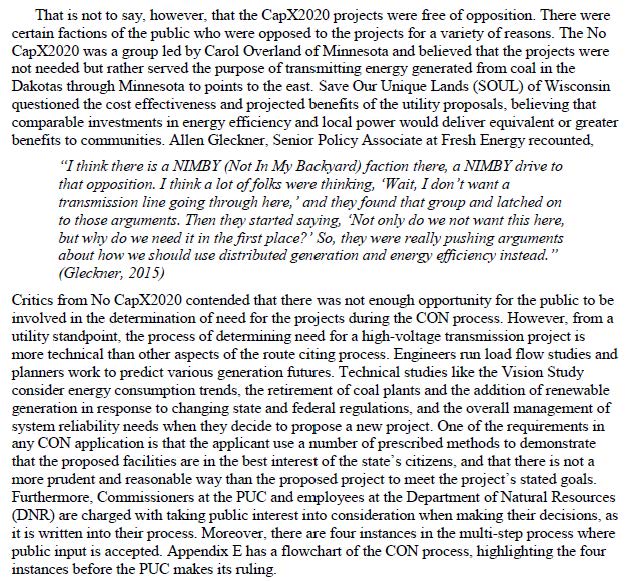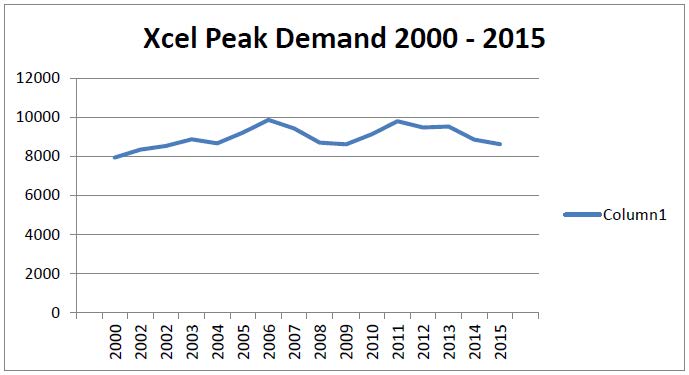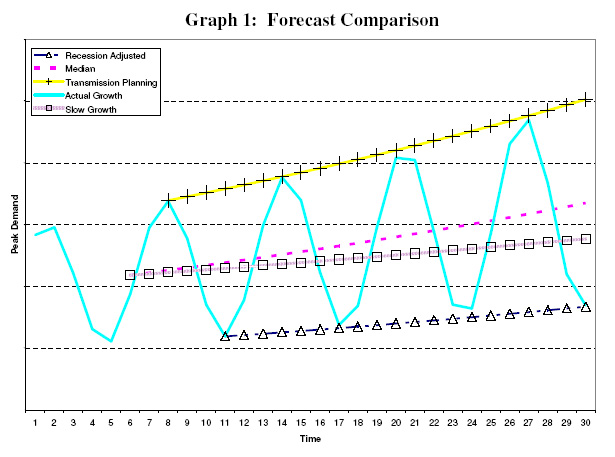U of M Humphrey “report” on CapX 2020
April 28th, 2016

It’s out, the report from U of M Humphrey School of Public Affairs about CapX 2020, headlining it as a “Model for addressing climate change.“
Transmission Planning and CapX 2020: Building Trust to Build Regional Transmission Systems
Oh, please, this is all about coal, and you know it. This is all about enabling marketing of electricity. In fact, Xcel’s Tim Carlsbad testified most honestly that CapX 2020 was not for wind! That’s because electrical energy isn’t ID’d by generation source, as Jimbo Alders also testified, and under FERC, discrimination in generation sources is not allowed, transmission must serve whatever is there. And the report early on, p. 4, notes:
Both North and South Dakota have strong wind resources and North Dakota also has low-BTU lignite
coal resources that it wants to continue to use. New high-voltage transmission lines are needed to
support the Dakotas’ ability to export electricity to neighboring states.See also: ICF-Independent Assessment MISO Benefits
Anyway, here it is, and it’s much like Phyllis Reha’s puff piece promoting CapX 2020 years ago while she was on the Public Utilities Commission, that this is the model other states should use:
MN PUC Commissioner Reha’s Feb 15 2006 presentation promoting CapX 2020
So put on your waders and reading glasses and have at it.
Here’s the word on the 2005 Transmission Omnibus Bill from Hell – Chapter 97 – Revisor of Statutes that gave Xcel and Co. just what they wanted, transmission as a revenue stream:

And note how opposition is addressed, countered by an organization that received how much to promote transmission. This is SO condescending:

… and opposition discounted because it’s so technical, what with load flow studies, energy consumption trends, how could we possibly understand? We couldn’t possibly understand… nevermind that the decreased demand we warned of, and which demonstrated lack of need, was the reality that we were entering in 2008.

And remember Steve Rakow’s chart of demand, entered at the very end of the Certificate of Need hearing when demand was at issue??? In addition to NO identification of axis values, the trend he promoted, and which was adopted by the ALJ and Commission, has NOT happened, and instead Xcel is adjusting to the “new normal” and whining that the grid is only 55% utilized in its e21 and rate case filings. Here’s Steve Rakow’s chart:

Reality peak demand trajectory was lower than Rakow’s “slow growth” line, in fact, it’s the opposite from 2007 to present. Suffice it to say:

PSE&G’s PR machine
July 2nd, 2009
Here’s their PR machine:
Here’s the poop:
New Poll Finds Strong Public Support for PSE&G’s Transmission Line UpgradeJul 1, 2009 12:38 AM
Public Service Enterprise Group Inc.A recent poll finds that the majority of people in Morris and Sussex counties in New Jersey favors PSE&G’s plan to upgrade the Susquehanna-Roseland transmission line to ensure reliability of the electric grid.
The poll, conducted by the firm of Luntz, Maslansky Strategic Research, showed approximately 3-to-1 support for the project, with 60 percent of those surveyed saying they “strongly support” or “somewhat support” it, compared to 22 percent who “strongly oppose” or “somewhat oppose” the line. Support for the line was equally strong regardless of the respondent’s proximity to the line.
“It is evident that most people understand that the existing line, which went into service in 1931, can’t be expected to handle today’s demand for safe, reliable electric service without an upgrade,” said Ralph LaRossa, president and COO of PSE&G.
“If we don’t act, Morris and Sussex counties, as well as all of northern New Jersey, could experience widespread brownouts and blackouts by the summer of 2012,” LaRossa said. “That’s not our judgment at PSE&G. It’s the verdict of the independent experts empowered by the federal government to manage the electrical grid. It’s a warning we take very seriously.”
The poll showed that 81 percent of the people in these counties see America’s energy situation as either a “crisis” or “major problem.” LaRossa added, “Most people who live in this area clearly understand the need to do what is required to maintain and ensure reliability.”
PSE&G, which funded the poll, is seeking permission to invest $750 million on the upgrade, adding a 500-kilovolt line to the existing 230-kilovolt line, within an existing transmission right-of-way. The project would create the equivalent of nearly 4,000 jobs lasting one year each, according to a recent report by senior economists at Rutgers University. And by relieving some of the congestion that drives up electric rates in New Jersey, it would help contain electricity costs for homes and businesses in the region.
The Board of Public Utilities is considering PSE&G’s petition to upgrade the line and is expected to make a decision by the end of the year. Public hearings were held on June 11 and 18 in Sussex County; a third hearing will be held June 30 in Morris County. In addition, the New Jersey Highlands Council is expected to vote on PSE&G’s request for an exemption for the project at its June 25 meeting.
The Luntz, Maslansky survey was conducted by telephone with 525 utility ratepayers across Morris and Sussex counties. The survey captured a statistically significant population of each county. To make sure the survey elicited the opinions of those ratepayers most likely to be affected by the project, the survey included an oversample of 100 respondents self-selected as living near the current transmission line, as well as an oversample of 100 respondents who lived in towns known to be near the existing transmission line. All respondents were registered voters. The survey was in the field June 4-11 and has a margin of error of plus or minus 4.3 percent at the 95 percent confidence level.